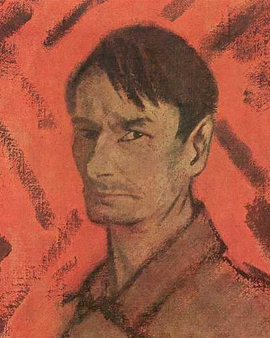Otto Mueller was one of the most important German Expressionist painters. His Gypsy Portfolio with nine colored lithographs, which he made only a few years before his death, is today considered the highlight of his artistic work. The portfolio was created during a trip to Sarajevo, where he was taken in by gypsies to live with them for some time. Otto was born in 1874. His rebellious character traits became apparent at an early age. As a result, he left high school without graduating. Before going to university, he first began training as a lithographer, but soon switched to the Dresden Art Academy. It was not long before the headstrong painter fell out with one of his professors. He repeatedly disobeyed instructions. After two years in Dresden, Otto Mueller moved to Munich and continued his studies at the Royal Academy of Fine Arts. But here, too, he was quickly dismissed. He works as a freelance nude painter and marries one of his models, Maria Mayerhofer. Together, the young couple moves from Munich to Berlin.
Here he discovers the graceful sculptures of Wilhelm Lehmbruck at an exhibition. He becomes friends with the famous sculptor. Wilhelm's works inspire Otto very much and he discovers his preference for glue colors and slender female figures, which would henceforth adorn many of his paintings. He also became interested in the artists' group "Berliner Secession". His efforts to join, however, fail - he is rejected by the movement's presidents. With a few other rejected painters, he therefore founded the artists' movement "Neue Secession". The members organize their first exhibition under the title: "Rejected by the Berlin Secession". After the exhibition he joins the Berlin artists' community "Die Brücke". The members share a similar style and a preference for muted color schemes. However, his artistic life was soon to take a drastic turn.
In 1915, the painter was drafted into military service. A year earlier, Austria-Hungary had declared war on Serbia. Otto is transferred to the front, first to France and then to Russia. A year before the end of the First World War, Otto fell ill with pneumonia, which he barely survived. After the end of the war, he worked for the first time as a professor at the State Academy of Arts and Crafts in Breslau. Here he joined the members of the "Breslau Künstlerbohème", which rejected any bourgeois conformity. His wife, who had dressed him after Breslau, divorced him in 1921 and returned to Berlin. Two more marriages followed, but they were quickly divorced. In 1930 Otto Mueller fell ill with tuberculosis and died after a few weeks in a specialist lung clinic in Breslau. His works were exhibited in many museums even after his death. When the National Socialists came to power, they confiscated 357 of his paintings - his works were henceforth considered "degenerate art". After the war, his paintings are exhibited again for the first time as part of the Kassel documenta.
×





 - (MeisterDrucke-194041).jpg)
 - (MeisterDrucke-194041).jpg)
.jpg)
.jpg)
 - (MeisterDrucke-42537).jpg)
 - (MeisterDrucke-42537).jpg)
.jpg)
.jpg)
.jpg)
.jpg)
.jpg)
.jpg)
.jpg)
.jpg)
.jpg)
.jpg)
.jpg)
.jpg)
.jpg)
.jpg)
.jpg)
.jpg)
 - (MeisterDrucke-163502).jpg)
 - (MeisterDrucke-163502).jpg)
.jpg)
.jpg)
.jpg)
.jpg)
.jpg)
.jpg)
.jpg)
.jpg)
.jpg)
.jpg)
_-_(MeisterDrucke-431958).jpg)
_-_(MeisterDrucke-431958).jpg)
.jpg)
.jpg)
 - (MeisterDrucke-232022).jpg)
 - (MeisterDrucke-232022).jpg)
.jpg)
.jpg)
.jpg)
.jpg)
.jpg)
.jpg)
.jpg)
.jpg)
.jpg)
.jpg)
.jpg)
.jpg)
_-_(MeisterDrucke-903044).jpg)
_-_(MeisterDrucke-903044).jpg)
 - (MeisterDrucke-300964).jpg)
 - (MeisterDrucke-300964).jpg)
.jpg)
.jpg)
 - (MeisterDrucke-591381).jpg)
 - (MeisterDrucke-591381).jpg)
_-_(MeisterDrucke-421677).jpg)
_-_(MeisterDrucke-421677).jpg)
.jpg)
.jpg)
.jpg)
.jpg)
_Peinture_dOtto_Mueller_(1874-1930)_(expressionnisme)_Huile_sur_-_(MeisterDrucke-1321059).jpg)
_Peinture_dOtto_Mueller_(1874-1930)_(expressionnisme)_Huile_sur_-_(MeisterDrucke-1321059).jpg)
.jpg)
.jpg)
_-_(MeisterDrucke-1315245).jpg)
_-_(MeisterDrucke-1315245).jpg)
.jpg)
.jpg)
 - (MeisterDrucke-94555).jpg)
 - (MeisterDrucke-94555).jpg)
_1926_-_(MeisterDrucke-805319).jpg)
_1926_-_(MeisterDrucke-805319).jpg)
.jpg)
.jpg)
.jpg)
.jpg)
.jpg)
.jpg)
.jpg)
.jpg)
.jpg)
.jpg)
.jpg)
.jpg)
 - (MeisterDrucke-102402).jpg)
 - (MeisterDrucke-102402).jpg)
.jpg)
.jpg)
.jpg)
.jpg)
 - (MeisterDrucke-591382).jpg)
 - (MeisterDrucke-591382).jpg)
_-_(MeisterDrucke-431957).jpg)
_-_(MeisterDrucke-431957).jpg)
.jpg)
.jpg)
.jpg)
.jpg)
_c1920_(lithograph_in_black_and_gold)_-_(MeisterDrucke-636720).jpg)
_c1920_(lithograph_in_black_and_gold)_-_(MeisterDrucke-636720).jpg)
_-_(MeisterDrucke-1071250).jpg)
_-_(MeisterDrucke-1071250).jpg)
.jpg)
.jpg)
.jpg)
.jpg)
.jpg)
.jpg)
.jpg)
.jpg)
.jpg)
.jpg)
.jpg)
.jpg)
.jpg)
.jpg)
.jpg)
.jpg)
.jpg)
.jpg)
.jpg)
.jpg)
.jpg)
.jpg)
.jpg)
.jpg)
.jpg)
.jpg)
.jpg)
.jpg)
.jpg)
.jpg)
.jpg)
.jpg)
.jpg)
.jpg)
.jpg)
.jpg)
.jpg)
.jpg)
.jpg)
.jpg)
.jpg)
.jpg)
.jpg)
.jpg)
.jpg)
.jpg)
.jpg)
.jpg)
.jpg)
.jpg)
.jpg)
.jpg)
.jpg)
.jpg)
.jpg)
.jpg)
.jpg)
.jpg)




